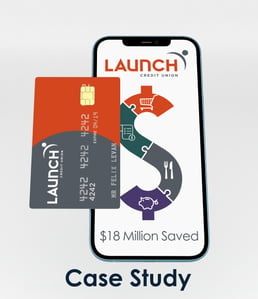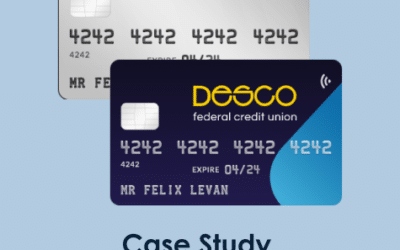- Engage fi
- Case Study
- Launch Credit Union
Launch Credit Union

Client
Launch Credit Union
“Hiring Engage fi back in 2014 was a brilliant move on my part. We worked through the card selection process confidently and the outcome helped advance the transformation of both our culture and our technology.”
Joe Mirachi | CEO | Launch Credit Union
Categories
Credit
Debit
Network Evaluation
Online Banking
Loyalty
Over the course of a nine-year partnership, Engage fi and Launch Credit Union have worked together to save the credit union over $18 Million!

-
Assets: $1,380,700,000
-
Members: 69,000
-
Headquarters: Merritt Island, FL
-
Branches: 20
GO BEYOND
Founded in 1963 as the Kennedy Space Center Federal Credit Union, the steadfast institution now known as Launch Credit Union has seen tremendous growth over the years. With $1,380,700,000 in assets, 20 branches, and nearly 80,000 members, Launch Credit Union has evolved from serving solely the Kennedy Space Center community to serving Brevard County, Volusia County, and beyond.
LAUNCHING FINANCIAL EDUCATION
Education is a pillar in the Launch community, and the credit union encourages its members to purchase “Support Education” vehicle tags, with a portion of the cost going directly back to education programs. The credit union also believes it is never too early to learn about the importance of finances and has two High School Branches in Volusia County where students can access their funds at the ATMs located on campus and visit the on-campus branch with any questions they might have regarding their financial well-being.
JOE MIRACHI: A CATALYST FOR CHANGE
Joe Mirachi joined Launch Credit Union (then still Kennedy Space Center FCU) as CEO in 2012. The credit union was approaching $600M in assets and had a strong capital position. However, it was quickly evident to Joe that although the credit union had done well since being founded in 1963, it had been floundering for the better part of a decade. Joe knew there would have to be major change to see the success he envisioned for the credit union.
The business model of a credit union is based on three key drivers: growth in deposit balances, growth in loan balances, and growth in the volume of payments. “Of the three, loan balances has consistently been the most important and high-performing driver credit unions excel at to generate quality loan growth. As such, of the three, loan balances was clearly the Achilles heel” of Launch Credit Union when Joe became CEO. Joe did a peer analysis of their loan balances and discovered it placed Launch CU in the 2nd percentile – meaning if there were 100 credit unions in a race, Launch CU was in 99th place.

Joe knew strategic change was needed. As he settled in as CEO, his assessment of the credit union focused on three key areas.
First, it became apparent that there was “no clear strategy” for the credit union. Born on Kennedy Space Center, in 1994 the credit union had merged with the teacher’s credit union from a neighboring county, and its field of membership expanded to a community charter covering two counties. However, despite this change in Brevard County, it functioned largely as the credit union for the space center and in Volusia County, it functioned largely as the credit union for the county school system. The merged credit unions continued to operate with a name that implied a restricted field of membership despite the change to a community charter. During the 2000s, the space center began to downsize with the imminent shutdown of the space shuttle program. As a result, the credit union began opening more branches out in the community but never made the other changes needed to serve more fully those not connected with the original two sponsor groups. In a word, the strategy was “muddled.”
Second, Joe noticed the culture of the credit union was “inwardly focused, complacent, and very resistant to change.” There were many long-term employees, and promotion was predominantly based on seniority and personal relationships. “Empowerment was almost non-existent, and staff were rewarded for keeping their head down and following orders. Cross-training and process improvement were largely absent. The culture supported the status quo and the leadership team saw themselves as a better than average credit union with no need to learn from others.”
Third, there had been an “under-investment in technology” for many years. Having been on a legacy core for 20 years, the credit union had signed a renewal for 7 more years just before Joe was brought in as CEO. The overall technology infrastructure was adequate – but limited in functionality and severely lacked integration capabilities. Overall, when Joe became CEO, he observed the credit union to be “well-capitalized but lacking a clear direction.”
With change on his mind and with the support of the credit union’s Board, Joe developed a strategic plan for the credit union that would drive significant change over time. The strategy focused on strengthening the core operations first and then shifting to faster growth. The goal was to become better at the products and services the credit union already offered before expanding the product line or expanding distribution channels. To ensure success, this meant improving the technology and the capabilities of the people. “Given years of little change, it was painful for many of the long-term leaders and unsettling for much of the staff. New technology began to be deployed and opting out of learning new systems was no longer permitted.” This new perspective invited some turnover of the credit union leadership, which in turn allowed for a shift in company culture.
A NEW ENGAGEMENT WAS IN THE CARDS
The foundation of a credit union’s technology – dubbed the “technology trifecta” – consists of three key systems: the core, cards, and digital banking. The contracts for Launch Credit Union’s core and digital banking systems had quite a bit of runway left, however, the contracts for their debit and credit cards were expiring within a couple of years. Less than 2 years into Joe’s tenure, Launch Credit Union began a project to replace the two separate card processing systems – one for debit and one for credit – into an integrated system with one company. Attempting to start the process internally, Joe recognized that the team was overwhelmed. Card technology, contracts, and pricing are all extremely complicated, and “the credit union team admittedly lacked the internal expertise to understand them well enough to make a good decision.”
Additionally, and even more concerning, the leadership team was “already being stretched to the limit and the team lacked anyone with the time necessary to dedicate to leading the effort.” Recognizing the lack of both the expertise and the bandwidth to handle this challenge, Joe began to fear the status quo was gaining the upper hand. It was about this time that Joe reached out to Engage fi for assistance in selecting the right payments partner and negotiating the best pricing terms. This opened a new door for Joe as now he could solve the combination of both the lack of expertise and the lack of leadership time. With the help of Engage fi, Launch could overcome the status quo and take a key step in the transformation of the credit union.

A LASTING PARTNERSHIP
The initial engagement between Launch Credit Union and Engage fi began in 2014 with a credit union that was struggling to remain relevant and competitive in their markets. Recognizing the need for assistance, Launch began working with Engage fi.
A few years after the initial partnership success, and having acquired some new internal resources and capabilities, Launch Credit Union selected a new digital banking provider without outside help. Unfortunately, the credit union did not end up with the best fit for them, and in 2020 hired Engage fi to help rectify the situation. As a result, Launch entered 2021 with another major conversion on the calendar.
In 2022, Launch Credit Union reached out to Engage fi to review their payment invoices. Like so many other financial institutions, Launch struggled to reconcile their vendor invoices with the contracts. Over a one year period, Engage fi recovered $124,000 in erroneous billing from a single vendor.
After completing these key projects with Engage fi and also strengthening their product and service offerings over the past several years, Launch’s strategy is now fully in growth mode. Additionally, “the cultural transformation has been remarkable as the pace of change is faster – yet comes more easily. The team quickly embraces new initiatives and readily adapts to a rapidly changing environment.” The term “status quo” to describe the credit union culture has been replaced with other terms such as collaborative, results-oriented, and even agile. And finally, with a new core system, the technology provided an integrated platform with plug-n-play functionality and flexibility. Launch continues to grow and do great things for their community. They launched a Merchant Lending program to help their local businesses grow and boost productivity. In the past 3 years, their business portfolio has grown to over $230 million with no delinquency.



